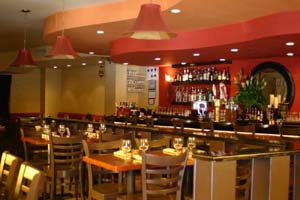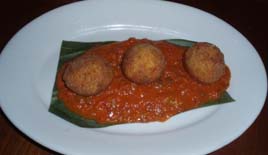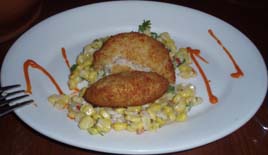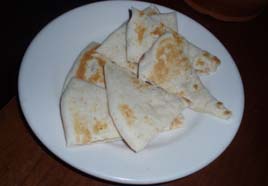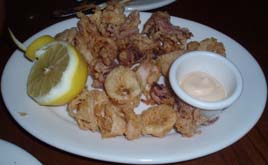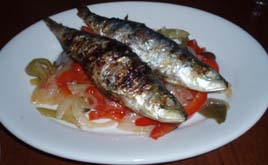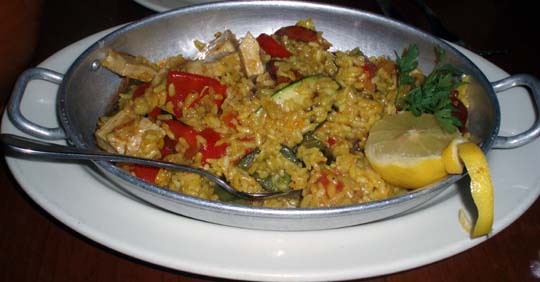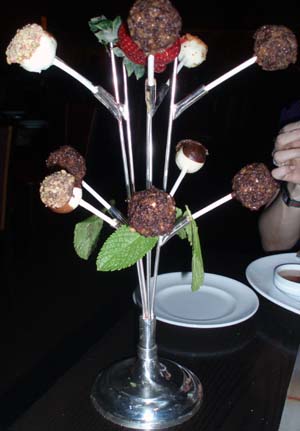
A visit to Blue Hill at Stone Barns requires some advance planning, or a bit of good luck. On two previous occasions, I made the trek up to Tarrytown without a reservation and dined at the bar. The bar accommodations are comfortable, but if all the seats are taken, you could be waiting for a while. On another occasion, I meant to do the same thing, but on arriving, we found to our dismay that the whole restaurant was closed for a private party.

Another barn on the premises. (This is not the restaurant,
although it is similar.)
If you want a reservation in the elegant formal dining room, you need to reserve two months in advance, to the day. I called about 45 minutes after the reservation line opened on February 14th. The evening of April 14th was already mostly sold out, with 5:30 p.m. and 9:45 p.m. being the only times available. Luckily, 5:30 suited our schedule, so I was finally able to dine at the restaurant with a proper reservation.
No restaurant better exemplifies the label haute barnyard. The cooking, service, and ambiance are about as elegant as can be; but the restaurant is literally co-located with a barnyard. The mission statement on the website seems almost too precious:

The cow logo is ever-present—
even on the weather vane.
Blue Hill at Stone Barns is a platform, an exhibit, a classroom, a conservatory, a laboratory, and a garden. The restaurant will reflect the spirit of the farm, the terroir, and the market. The kitchen will express the humanity and the fervor of the educators, preservationists, farmers, cooks, and servers who learn and work at the Center.
Reading that, you wouldn’t know whether to expect dinner or a lecture. Indeed, the staff are mighty proud of the farm. At some point in your meal, a server brings around a tray of greens, to show you all the seasonal herbs that are featured in the day’s menu. But none of that would matter if the food didn’t live up to the billing. Which it does.
The restaurant is operated by the same team that run Blue Hill in Greenwich Village. I’ve now visited both restaurants three times. I don’t know why, but the original Blue Hill in the city doesn’t generate the same excitement as Blue Hill at Stone Barns. At Stone Barns, the menu is much more creative and eye-popping, the progression of tastes far more extravagant.
 The dining room is in a converted barn, elegantly appointed. When we arrived, there was still ample daylight shining through the windows. By the time we left, it was quite dim, with the only light coming from a handful of sconces and candles at each table. Most guests dress up to dine here, though we did see a few people in jeans.
The dining room is in a converted barn, elegantly appointed. When we arrived, there was still ample daylight shining through the windows. By the time we left, it was quite dim, with the only light coming from a handful of sconces and candles at each table. Most guests dress up to dine here, though we did see a few people in jeans.
After we were settled in, the server recited a list of house cocktails, all based on the “barnyard” theme. I couldn’t resist trying one made with carrot juice and hay-infused vodka, which was much better than it sounds. (In the photo, you’ll notice that even the stirrer is a piece of straw.) We saw plenty of these coming out of the kitchen, so I wasn’t the only one intrigued.
A diner at another table noticed that the tall glass still had a price tag on it. We noticed this too, but considered it too minor a matter to point out. The other table mentioned it, and the server took the drink off both bills. (In the photo, you can just barely see a white price tag shining through the bottom of the glass.)
The menu changes daily, to take advantage of the latest seasonal ingredients. There is a choice of three courses at $65, four courses at $78, or the farmer’s feast—a tasting menu with six courses plus multiple amuse-bouches—at $110. As we so often do on such occasions, we ordered the tasting menu.


Bread service (left); Cream of cauliflower soup(right)
The bread service is spectacular. Each of the rolls (above, left) suggests a “book,” whose pages you pull apart. The soft butter it comes with is wonderful. The first amuse was a cream of cauliflower soup with a drizzle of basil olive oil. It also came with a tiny breakfast radish and two dried vegetable chips. One of these was a beet chip, which looked like a potato chip, but was about as thin as a human hair.


“Beet Burgers” (left); Foie gras and chocolate (right)
The next two amuses were extraordinary: “Beet burgers” (beet and goat cheese on a micro-bun) and bites of foie gras in a chocolate sandwich.


Walnut bread with two salts (left); Mango-crabmeat cannoli (right)
The last amuse consisted of two contrasting salts—the one at the top of the photo is “carrot salt,” with walnut bread. I had to admire the creative impulse, but the taste of salty bread wasn’t really that intriguing.
The first savory course was a crabmeat cannoli wrapped in mango so thinly sliced that it yielded instantly to the touch. This flavor combination worked perfectly.


Green salad (left); Sturgeon (right)
A green salad had enough herbs and vegetables to fill a botany textbook, but offered little excitement to the palate. Sturgeon was served over citrus braised fennel with a fig sauce. The sturgeon was impeccably prepared, but fish, fennel and fig were all overwhelmed by the tartness of the citrus—which was presumably grapefruit.


Gnocchi (left); Venison (right)
A delicate gnocchi was prepared with ricotta cheese, sweet potato, a roasted chestnut, and parmesan. Good as it was, we couldn’t help admiring the serving bowl, which was large enough to be the conversation piece on our coffee table at home. We wondered where we could buy them?
Venison was the final savory course. My girlfriend, who normally doesn’t like venison, thought it was terrific, while I found it dull. Perhaps I was just over-fed by this point.


Palate cleanser (left); Dessert (right)
 The palate-cleanser was house-made yogurt with citrus accompaniments; we noted that the citrus worked here much better than it did with the sturgeon. I don’t recall the exact description of the dessert, but it was excellent. So too were the petits-fours (right), but I was far too full to taste more than one of them.
The palate-cleanser was house-made yogurt with citrus accompaniments; we noted that the citrus worked here much better than it did with the sturgeon. I don’t recall the exact description of the dessert, but it was excellent. So too were the petits-fours (right), but I was far too full to taste more than one of them.
Service throughout the evening was first-class. Water glasses were always promptly refilled. The wine was decanted, and our glasses kept full. The pacing of the courses was about right, with the meal unfolding over about 3½ hours. Servers were enthusiastic and well informed about the food.
While a few of the courses weren’t hits, the overall quality of the meal was quite high. Whether one liked a particular item or not, it was always clear that abundant thought and care had gone into its preparation. After three visits, I can say that Blue Hill at Stone Barns is one of my all-time favorite restaurants.
Tarrytown, the closest Metro-North stop, is under an hour’s train journey from Grand Central. The restaurant is about ten minutes’ ride from the train station, and there are always taxis waiting. At the restaurant, just notify the staff about fifteen minutes before you are ready to leave, and they’ll call a taxi for you. It’s a bit of a schlep to get there, but well worth it.
Blue Hill at Stone Barns (630 Bedford Road, Pocantico Hills, New York)
Food: The ultimate expression of American locavore cuisine
Service: Elegant, crisp, and correct
Ambiance: A lovely haute farmhouse, located on the farm itself
Rating: ★★★★
 Wednesday, April 18, 2007 at 06:26AM
Wednesday, April 18, 2007 at 06:26AM  David Pasternack,
David Pasternack,  Esca,
Esca,  Joe Bastianich,
Joe Bastianich,  Mario Batali in
Mario Batali in  BruniBetting
BruniBetting 



















